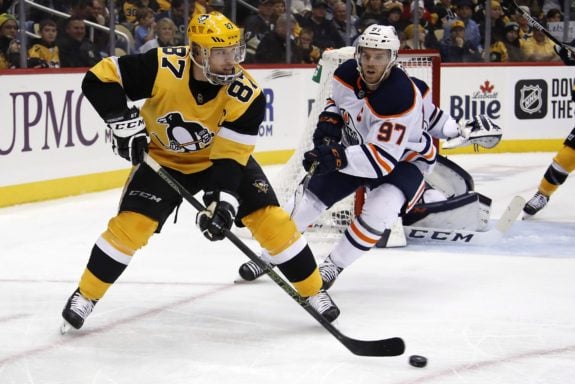In the hallowed Pittsburgh Penguins tradition, head coach Mike Sullivan keeps his troops chugging along despite the lengthy absences of several of the team’s familiar stars, including that of captain Sidney Crosby. After missing the start of the season to recover and recuperate from offseason wrist surgery, Crosby is fully practicing, which suggests his season debut is imminent. Due to the welcome emergence of a solid, but unassuming supporting cast and sparkling underlying numbers, the Penguins look poised to challenge for the Stanley Cup once the cavalry returns to full strength. It’s still extremely early in the season, so what’s been observed could simply be noise. With that, let’s dig into how they’ve flipped the script after a disappointing end to last season.
Unsung Penguins Step Up in Stars’ Absence
The Penguins seemingly hold the lone key to the “No-Name Turned Star Overnight Factory” (patent pending), and their promising start to the 2021-22 campaign indicates that the locks haven’t been changed just yet. Through six games, the trio of Danton Heinen, Drew O’Connor, and Evan Rodrigues leads Pittsburgh in scoring with five points apiece. Their unexpected production combined with Tristan Jarry’s resurgence in net (.933 save percentage) means that the Penguins can claim an Eastern Conference wildcard spot through the first two-and-a-half weeks of the season.
Much of their success is a direct by-product of the dominance of their forwards, as the line comprised of an unlikely unit in Rodrigues, Jason Zucker, and Kasperi Kapanen has been a two-way juggernaut. They’ve accounted for just under 70 percent of expected goals (xGF%) and nearly 62 percent of shot attempts (CF%) at five-on-five, both among the top six forward lines with at least 30 minutes played. Zucker and Kapanen have each supplied four points in six games, a twin offering of a 50-point-pace over 82 games. Suppose they can maintain their production once Crosby, Evgeni Malkin, and Bryan Rust return to full health. In that case, the Penguins can suddenly roll out an unrelenting legion of scoring talent.

Elsewhere, the team’s designated shutdown crew of Zach Aston-Reese, Teddy Blueger, and Brock McGinn has steadily controlled play while munching difficult even-strength minutes. The Penguins’ most frequently used forward line is running on a 55.6 xGF% rate, giving the offensive contributors welcome reprieve and allowing Sullivan to breathe easy when combatting the opposition’s most dynamic attacking units.
On the blue line, Pittsburgh’s de-facto top pair of Marcus Pettersson and John Marino has admirably held the fort in Kris Letang’s stead. Not only has the duo directed play with ease at five-on-five (61.3 xGF%), but their defensive impacts have been almost unparalleled thus far. Among defense pairs with at least 40 minutes played the frequency at which they concede expected goals (xGA/60) against ranks second in the NHL, behind only the Boston Bruins’ Charlie McAvoy and Matt Grzelcyk. They are just as authoritative in terms of actual goals, as Pittsburgh has outscored opponents 5-0 with the two on the ice. When Letang returns, the team can boast two legitimate pairings capable of either driving offense or reliably suppressing chances against. Look out.
Underlying Results Paint Penguins as Legitimate Contenders
Even as a few pistons push the Penguins to an unexpectedly strong start, it’s important to contextualize the team’s success as a whole. Pittsburgh has been decent possession-wise, currently ranking 11th in Corsi for percentage (CF%), which means they generally control the majority of play at five-on-five. They’ve distinguished themselves in their results pertaining to chance quality, particularly on the defensive end.
You May Also Like:
- Penguins’ Kyle Dubas Already on the Hot Seat This Season
- 4 Things Patrick Roy Can Learn From Jon Cooper & Mike Sullivan
- Pittsburgh Penguins’ 10 Best Defensemen in Team History
- Hockey History – the NHL “Second Six”
- Penguins’ Projected 2024-25 Opening Night Lineup
The Penguins are currently the second-best team in the NHL in terms of xGF%, flaunting a 55.9 percent mark at five-on-five. Their dominance is primarily driven by their ability to suppress chances against. The team has only conceded 1.76 xGA/60 because of their commitment to Sullivan’s cohesive defensive structure and the individual players who successfully leverage their defensive awareness to force shots to the outside. Their middling ability to drive expected goals for (xGF/60) restricts Pittsburgh from being outright Cup favorites, although the return of their offensive lynchpins should change that in a hurry.

Similarly, the Penguins regularly subdue opposing offensive strategies by leaving their adversaries with no choice but to resort to low-percentage attempts on goal. By high-danger chances (from the slot and surrounding the crease), Pittsburgh allows 8.17 opportunities against per-60-minutes (HDCA/60) at five-on-five, third in the NHL. They successfully restrict opponents from accumulating a multitude of scoring chances and collectively limit the number of particularly threatening shots that Jarry faces each game. MoneyPuck has Jarry at 4.1 goals saved above expected through his first five starts, the fourth-highest total this season. Pittsburgh clearly does its best to hand him a manageable workload, but he’s done his job when called upon.
Crosby Remains An Integral Leader
Not much needs to be said about Crosby’s stature in Pittsburgh and around the league. Even on the back nine of his career, the three-time Stanley Cup champion is still arguably the league’s pre-eminent two-way force. Crosby’s 62 points in 55 games last season (10th in the NHL) powered the Penguins’ to the East Division crown. That he accomplished such a feat while simultaneously nursing a lingering injury from 2014 is remarkable. A rejuvenated captain coupled with refreshed secondary units has Pittsburgh eyeing a fourth Stanley Cup in the Crosby era. After falling flat in 2021, the team is ready to avenge its untimely downfall. Who’s going to bet against the NHL’s 21st-century darlings?
Data courtesy of Hockey Reference, MoneyPuck, and Natural Stat Trick.